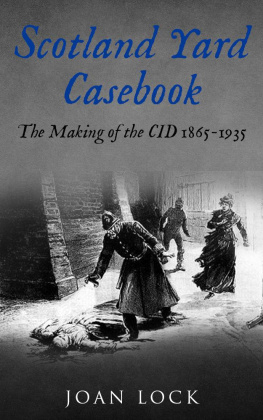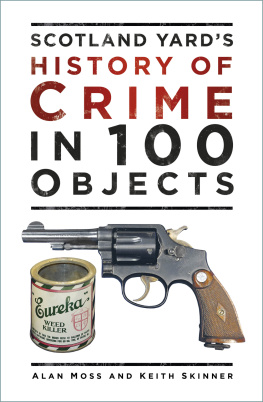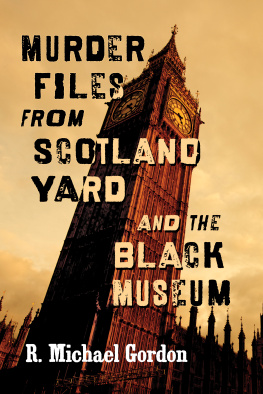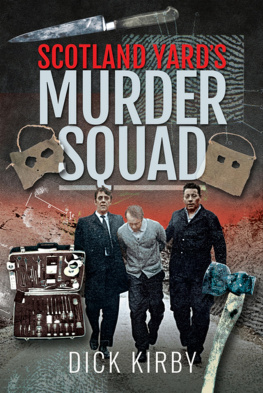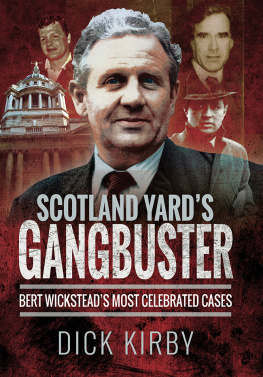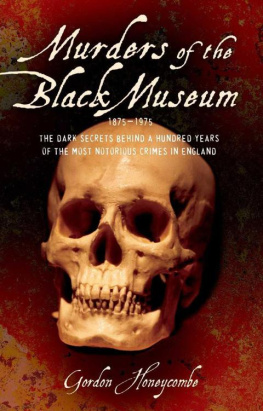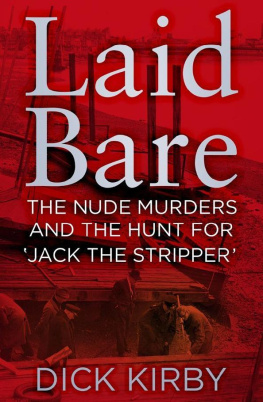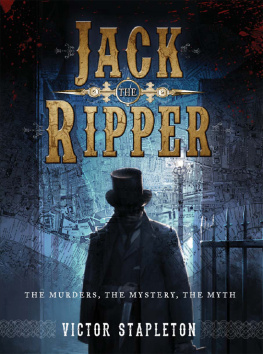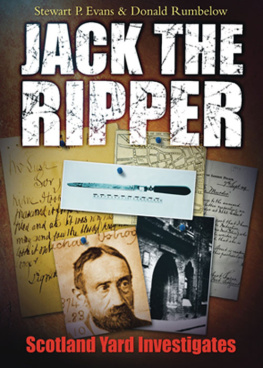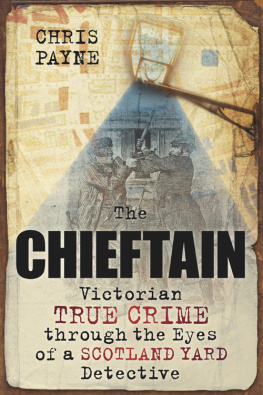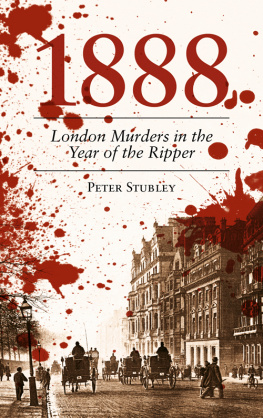Scotland Yard Casebook
The Making of the CID 1865-1935
Joan Lock
Copyright Joan Lock 1993
The right of Joan Lock to be identified as the author of this work has been asserted by her in accordance with the Copyright, Designs and Patents Act, 1988.
First published in the United Kingdom in 1993 by Robert Hale.
This edition published in 2014 by Endeavour Press Ltd.
Table of Contents
Part I: FIRST CHANGES
1 Cry Wolf
The scene which greeted burly Detective Inspector Thomson just before Christmas 1864 was one of dreadful poverty. Not only had Ernest Southey and his common-law wife, Mrs White, been without heating, food and adequate clothing for some time but they faced the immediate prospect of losing the roof over their heads.
The detective had been sent down to see them at their Putney lodgings as the result of a letter Southey had written to the Foreign Secretary, Earl Russell, claiming he had information he wished to impart. Obviously, there was a suspicion that the man might be a crackpot with dangerous delusions. Indeed, continued privations and want of the ordinary necessaries of life had, Thomson noted, brought the couple to the borders of insanity. But, in his opinion, Earl Russell could relax, for the only people they seemed likely to harm were themselves.
The 29-year-old Inspector James Jacob Thomson was an educated man by police standards at the time, and the report he submitted to his Commissioner, Sir Richard Mayne, was eloquent on the couples direst misery. Consequently, as with A Christmas Carol , written by Charles Dickens twenty-one years earlier, this Yuletide tale had a happy ending at least temporarily. It must have gladdened the heart of the kindly Thomson and, to some degree made up for missing out on his own festive celebrations when, on Christmas Day, he handed Ernest Southey a gift from Earl Russell one sovereign. Mr Southey, the detective reported back, was deeply grateful. And so he might be. The weekly wage of most police constables at the time was exactly that amount.
It transpired that Southey, who was from a respectable family and had the appearance of a well-educated person, had not so much information to impart but a grievance he wanted aired. He had fallen on hard times but his life had picked up after going to live in Brighton and becoming a billiard player. Billiards was a game popular with the upper classes and, through his expertise, Southey had not only made the acquaintance of several eminent people but also a great deal of money, playing for high stakes. On one occasion, so he claimed, he had a wager with the Honourable Dudley Ward which should have netted him 1,172 but alas, Southey alleged, Dudley Ward proved to be honourable in title only. He merely handed Southey a memo of the debt, promising to pay up the following day, then left the country.
Meanwhile, the billiard player had met Mrs White, a well-educated woman with four children, three boys and a girl, who, after leaving her husband, had attempted to support them by running a school. In this she failed, so, to feed her offspring, she had, Thomson reported, deviated from the path of virtue. Nonetheless, like Southey, she possessed many testimonials to her character and her manner was becoming.
Following his setback with the Hon. Dudley Ward, Southeys fortunes had faded fast. The boys were sent back to their father who ran a school in Holborn. Southey and Mrs White, unable to afford a divorce for her, set up as man and wife at a variety of lodgings. At one point they went to Worcester where Mrs White was sent to see the wealthy Lord Dudley, brother of their alleged debtor, but he refused to acknowledge any responsibility and ejected her. She summonsed him for assault, but the case was thrown out by local magistrates after Lord Dudley had publicly referred to the lady as a prostitute.
Now, smarting even more, and having exhausted the charity of friends and relatives, the couple were lodging in Putney but owed seven weeks rent and were asking that the Earl Russell (popular with the people due to his championing of parliamentary reform and better known as Lord John Russell) act as an intermediary for them with Lord Dudley. Should assistance be refused, reported Inspector Thomson, they have resolved to poison themselves and have written a narrative to the coroner to be read by him at the inquest on their bodies.
On 30 December, Southey turned up at Scotland Yard where he saw the ageing and exhausted Commissioner, Sir Richard Mayne. He also wrote another long letter to Earl Russell, telling his tale and informing him that the dread means to escape their ruined and hopeless existence had already been purchased. The 72-year-old foreign secretary was one of Queen Victorias two terrible old men (the other being her Prime Minister, Lord Palmerston). Russell now exercised the same principles he employed with regard to the American Civil War and that long-running territory dispute, the Schleswig-Holstein Question those of non-intervention. And there the matter rested. For the moment.
That year of 1864 had been one of the better ones for the Metropolitan Police, despite an increase in crime due to the cessation of transportation. The detective branch, particularly, had shone after 33-year-old Inspector Richard Tanner had dashed across the Atlantic to waylay and arrest the first railway murderer, Franz Muller, who was crossing on a slower ship.
Launched in 1842, thirteen years after the birth of the Metropolitan Police, the detective branch operated from Scotland Yard (although by now there were a few detectives out on the divisions). As well as being called in to handle difficult cases, the Scotland Yard men also went out thief catching at the races or other social gatherings which attracted both crowds and those who preyed upon them. They remained, however, remarkably few in number. At the outset only eight had been appointed six sergeants and two inspectors. By 1865 there were eleven two more sergeants and one more inspector. The popularity of this select group, like that of the rest of the force, waxed and waned in line with their efficiency (or, rather, their perceived efficiency) or lack of same.
The detectives were famous not only because their names were invariably mentioned whenever their cases were reported in the newspapers (and most cases were reported in remarkable detail), but also due to the fact that the detective branch had been taken up by Charles Dickens. In 1850, he had invited several of them to his Household Words office, plied them with brandy and cigars and later retold, with obvious admiration and approval, their tales of pursuit and capture. They were upright men who nonetheless gave the impression of habitually leading lives of strong mental excitement, he told his readers. The last of Dickens detectives, former labourer, Inspector Jonathan Whicher, said to be the most brilliant of them all, had in fact only just retired suffering from mental depression arising from congestion of the brain.
Inspector Thomson was typical of the second-generation detectives, taken on as much for his education and linguistic abilities as for any thief-taking skills. Born in Turkey of a Scottish businessman father and an Italian mother of some social standing, he had been brought up to speak English, French, Italian and Greek. His first employment had been concerned with the new science of electricity, his second, as an assistant secretary to an Indian prince. In 1855 the prince had returned to Calcutta so the following year, partly from choice, partly from necessity, Thomson joined the Metropolitan Police as a constable. He didnt stay long, however, leaving the following year to join the Devon Constabulary and later transferring to Hampshire.
In 1862, Sir Richard Mayne had asked him back, allowing him direct entry into the coveted ranks of the detective branch as a sergeant, and he was fast proceeding up the ladder. His knowledge of foreign languages was invaluable to a department increasingly involved in complicated extradition matters and cross-channel crime. Not only that, many of their more serious cases emanated from the simmering ranks of Londons European refugees, who were forever fighting among themselves or with the natives, in between giving language lessons and plotting revolutions. (Plotters in an 1857 assassination attempt on the French Emperor had their bombs made in Birmingham and tested them in Putney until the neighbours complained.)
Next page
